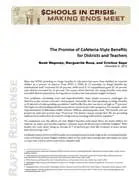Since the 1970s, spending on fringe benefits in education has more than doubled in constant dollars as a percent of salaries. From FY05 to FY08, K–12 spending on fringe benefits for instructional staff increased by 28 percent, while total K–12 expenditures grew by 20 percent and salaries increased by 16 percent. Nationally, the total spending on fringe benefits is 33 percent of total spending on salaries, and locally, this rate can rise to as high as 75 percent.
Escalating costs and unpredictability pose enormous challenges for districts in the current economic environment. The high cost of providing benefits means fewer resources for other programs and fewer dollars for salaries.
This brief describes how a different method of supplying benefits to employees might work for districts: cafeteria plans. While typical school district plans offer a one-size-fits-all package of benefits to employees, cafeteria plans allow employees to customize their benefits within a given cost.
The analysis considers a hypothetical cafeteria plan with a set worth and a menu of options that allows teachers to create benefits packages based on their preferences. For example, a second-year teacher without a family might make different choices regarding health insurance, life insurance, and sick days than a 15-year veteran with a family. The brief also describes how a district might structure cafeteria plans, each with different implications for predictability and stability of costs.
With federal recovery funds depleted, state budgets constrained, and projected increases in benefits costs, districts will be under increasing pressure to reign in escalating benefits costs and build in more budget stability. Cafeteria plans might help districts to do both, while at the same time making sure that funds are used in ways that work to attract and retain valuable staff.





